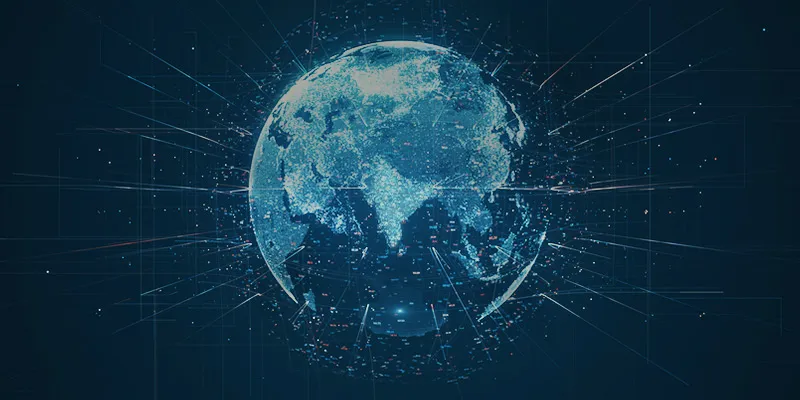How ready is India for artificial intelligence?
Revolutions do not always follow a linear timeline. They can be sporadic and unpredictable. NITI Aayog’s roadmap for national Artificial Intelligence programme hopes to bring one such revolution.

The allocated Rs 3,073 crore will spearhead work on fifth generation technology startups like Artificial Intelligence, Machine Learning (ML), Internet of Things (IoT), 3D printing and Blockchain.
The magnanimity of effort can be gauged by the near doubling of the fund for the programme. Atal Innovation Mission can give Rs 10 crore to start-ups that fit the criteria. In all, Rs 200 crore has been allocated in 2017-18. India is ready to take the AI-assisted leap of faith, with pre-meditated outcomes for before, during and after the leap.
The oncoming revolution has to go through mountains of paperwork, maze of data silos, and murky data lakes before any form of AI can begin to make sense of the haphazardness that is India. Let’s tackle some important questions when it comes to these futuristic technologies.
Where do we stand now?
The next generation of technology is seeing exponential growth. The overall picture is blurry though, due to the extremes we need to be navigating. To crunch some numbers, according to reports, there are more than 200 AI-based start-ups in India.
In a March-June 2017, a Capgemini survey of nearly 1,000 companies in India with revenue of over $500 million, found that around 58 percent have gone beyond pilot and test projects and are adopting the technology at a larger scale. The number of Internet users in India is expected to reach 500 million by June 2018, it’s the second largest online market in the world.
At 160 million WhatsApp users, we having a generation of people who skipped any computer learning and straightaway became mobile consumers of the internet.
Let’s begin with data. AI functions are directly proportional to the amount of data and the kind of data fed into the system. In the case of India, the largest database is built with Aadhaar - 99 percent of India’s population - a staggering 1.19 billion records.

Aadhaar is the world’s largest biometric ID system and India’s first foray into scaled up technology has no precedent. And this is precisely why the Aadhaar comes with its own set of unique challenges.
The first challenge is how much of the data is personal? Does a collection of retinal scans and finger print breach the right of privacy? Aadhaar is mandatory for one service after another - phone numbers, ration cards, bank accounts, income tax filing. All of the interlinked data will be available to government to garner insights using AI. In the larger scheme of things, this data will be linked to hospital records, land records, purchases, this could be made visible or sold to interested parties, legally or illegally.
The second challenge is of course, security. It is impossible to create a non-hackable system. Aadhaar opens up a minefield of security lapses, where the hacked data can be used to cause harm to a person or society. As pointed out by media, there have been lapses in the past wherein the data has been leaked or sold or hacked into. The government needs to make stricter laws and plug in loopholes when it comes to Aadhaar data.
The third and yet unseen challenge is the moral implications of using AI, because there is no universal right or absolute wrong in this case. Every case differs from the other. This is the most difficult challenge of all, because there is limited data to study the new scenarios that will be originating when AI will be using countrywide data to garner insights.
Let’s take the case of linking Aadhaar to medical records. In times of disasters, floods, fires, train accidents - fingerprint identification and medical history of a patient available to a medical profession will be the factor determining life and death. Analyzing the cases of particular diseases in a specific region, could help predict epidemics before they break out.
Websites and apps query people if they are willing to share crash data with developers to better the systems over a period of time. Will hospitals give out similar consent forms to people if they are willing for their data to be used in analyzing patient records by AI to look for insights that have escaped the human eye.
Personal data is a double-edged sword. Enterprises and governments can make use of data for a variety of scenarios when it helps people, but cases of blatant misuses will also be flaring up in huge numbers. Medical records of employees help an organisation in times of emergency care for employees with medical histories, like heart condition or diabetes. But the same data can be used for discriminating against employees that have a medical condition like mental health issues or HIV-AIDS.
What needs to be done for enterprises to adopt AI solutions?
Create secure, usable, scalable data

Data is the smallest and most important unit of an AI system. AI is all set to revolutionise manufacturing, transport, healthcare, finance and retail to name a few. But, the biggest problem in India, across industry verticals, is the severe paucity of usable data. We need to create a system to convert records on paper to create data lakes for Machine Learning (ML) to take over from humans. ML will start to analyse data, and then an AI-enabled system learns by itself and provides actionable insights.
The mindset needs to shift from find and fix mentality to that of a preventive maintenance.
The major barriers to storing data digitally is lack of trust, time, and the inertia to shift from existing systems. Digital data is not considered tamper-proof. Take real estate for example. You have to get a stamp paper to a registrar, and get the documents in your name. For smaller transactions too, a paper bill is preferred over an email.
A majority of all our transactions are physical. We need a simplified, encrypted digital transaction system that is easy to adopt. Government departments - legal, transport, medical, educational - carry majority on their transactions on paper, creating silos after silos of static, non-usable data.
The existing data is not centralised, creating a disorganised data maze that is impossible to navigate. The digital revolution needs to first start creating organised, usable, accessible data.
Create the ecosystem to train AI professionals
Around 4,000 positions in the field of AI are vacant in India due to the insufficiency of talent. Kelly OCG India reported that India would see a 60 percent rise in demand for AI and ML professionals by 2018. It’s difficult for Indian companies to attract talent from outside the country.
Educational institutes need to scale up and be better equipped for the changing demand for new technologies. A change in curriculum as well as opening new colleges, specifically dedicated to higher studies in the fields of Machine learning, Big data, Cloud computing, Blockchain and AI is the need of the day.
We need to start to develop in-house talent to cater to the exceeding demand for skilled professionals.
Online courses in AI and Machine Learning from industry leaders like Andrew Ng on Coursera are very helpful to companies that want their workforce to upskill and stay relevant.
AI is not a magical cure for all problems

Every industry has specific requirements where the use of AI can help tremendously. Manufacturing, healthcare, education, transport: every vertical gains from the use of AI. An enterprise needs to have an understanding of the timeline of the solution, resources allocated for it, financial implications and the fact that AI doesn’t always have a tangible Return on Investment in the short term.
The results can often point to long-term advantages. AI can give results, there is a timeline of training the solution to be able to derive actionable insights. The learning curve is often steep.
Natural Language Processing is another roadblock as the availability of NLP in any Indian language is scarce. Indian English contains words spoken colloquially and often has a mix of some words in people’s mother tongue. AI needs to train systems on the variety of colloquial terms used in Indian English.
Going by the success of HDFC Bank’s chatbot, OnChat, the feat is not impossible to pull off. OnChat can effectively process a mix of Hindi and English and converse with customers to transact for bill payments, mobile recharges, booking travel etc. It has also garnered 160 percent month on month growth, garnering 2.4 million messages.
Start-ups can provide better solutions for AI projects
India has a great scope for start-ups that work in the AI space. Due to the small size of a team of dedicated resources involved with a project, there is better coordination between the UI/UX designers, architects, developers, data scientists and the client. A smaller team also means shorter turn-around time for agile requirements of the client. Feedback can be incorporated faster into the solution. Smaller teams lead to ownership among team members who are aware of the bigger picture and their contribution to it. The absence of a defined protocol and time-taking processes leads to a fluid work environment where the client can work closely with the team working on the AI solution.

Innovate
There are many start-ups in India creating chat-bots, financial solutions and medical scan solutions. But what will really give Indian companies an edge is their ability to find out AI solutions specifically suited to solve in-house problems.
A NLP chatbot can bridge the language gap between the English knowing and non-English knowing population of India by having multi-language support. Using AI to recognise handwriting across different languages in India will simplify data entry and help in creating a clean data lake. Currently, most websites support the Roman keyboard, alienating millions of Indians from using the internet. Native language support on the rail bookings app will save the time and energy wasted in traveling to a railway station to book tickets.
AI can create a transparent system and bring on a revolution in agriculture. Providing real time selling price of crop across nearest markets, cost-analysis of transport to farther markets, prediction for market rates in coming weeks and months, route-map for nearby storage units can all be fed into a centralised system and provided to farmers. Peer to peer discussions, best practices, weather updates, tractor rentals - there is a lot that an AI enabled solution made for India can achieve.
The start-ups in India are fully aware of the shortcomings and work with it to evolve AI solutions that are India ready.
Take that AI enabled leap of faith
India is a developing nation where we are still struggling with poverty and providing food and shelter and fulfilling basic needs of being a human being. But, in prioritizing food and shelter, we haven’t put our dreams on hold.
The question is, are we, as a country, ready for AI?
The answer is a complex, ‘we don’t know’. But we are not going to find out, unless we go ahead and do it anyway. Time to consult our AI solution and take that AI enabled leap of faith.
(Disclaimer: The views and opinions expressed in this article are those of the author and do not necessarily reflect the views of YourStory.)







